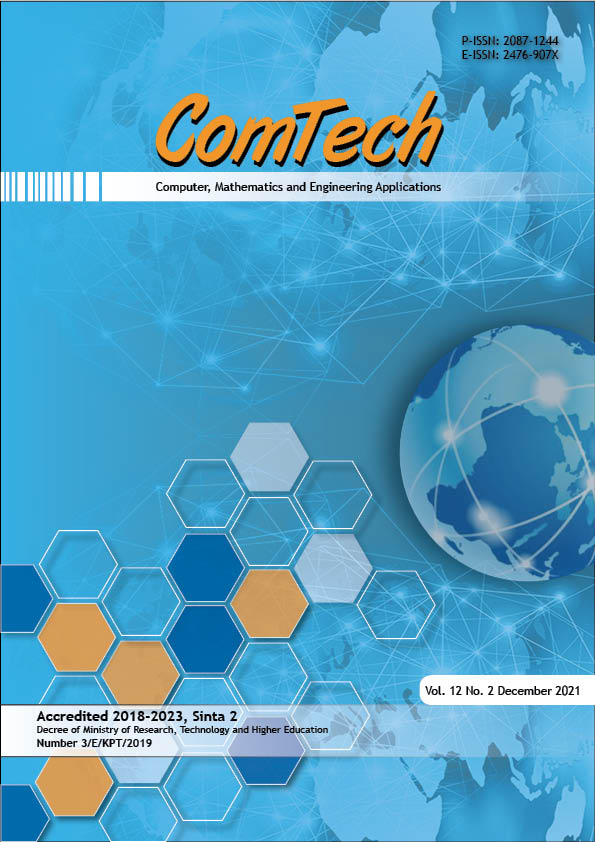Redesign of E-Commerce Mobile Application with Design Thinking Method: A Case Study of RP2, Online Household Retailer
DOI:
https://doi.org/10.21512/comtech.v12i2.6851Keywords:
e-commerce, mobile application, design thinking methodAbstract
RP2 is one of the growing e-commerce sites in Indonesia offering products for home and living. Recently, RP2 launches a mobile application to reach users by using mobile devices to facilitate purchases on RP2. However, the development of this mobile application has not been through a good application development process, so several weaknesses are found. The aim of the research was to redesign the RP2 mobile application using the design thinking method. The method had five stages: empathize, define, ideate, prototype, and test. However, the research only focused on the first four stages. Moreover, a survey using a questionnaire and interviews were done with 34 users of the RP2 mobile application. The research results are a prototype of the RP2 mobile application, which has been tailored to users’ needs and the project owner’s input. Changes have been made to the RP2 mobile application using the design thinking method. Changes are applied in several views, such as home, navigation and notifications, search bar, Product Detail Page (PDP), cart and payment, and profiles. With these changes, it is expected that users of the RP2 mobile application will increase, so the number of transactions through the RP2 mobile application will increase too.
References
Asosiasi Penyelenggara Jasa Internet Indonesia. (2018). Hasil survei penetrasi dan perilaku pengguna Internet Indonesia 2018. Retrieved from https://www.apjii.or.id/content/read/39/410/Hasil-Survei-Penetrasi-dan-Perilaku-Pengguna-Internet-Indonesia-2018
Bilgihan, A. (2016). Gen Y customer loyalty in online shopping: An integrated model of trust, user experience and branding. Computers in Human Behavior, 61, 103-113. https://doi.org/10.1016/j.chb.2016.03.014
Casare, A. R., Da Silva, C. G., Basso, T., & Moraes, R. (2021). Towards usability interface trustworthiness in e-commerce systems. In International Conferences Interfaces and Human Computer Interaction 2021.
Dam, R. F., & Siang, T. Y. (2020). What is design thinking and why is it so popular? Retrieved November 20th 2020 from https://www.interaction-design.org/literature/article/what-is-design-thinking-and-why-is-it-so-popular
Kamran, R., & Dal Cin, A. (2020). Designing a Mission Statement mobile app for palliative care: An innovation project utilizing design-thinking methodology. BMC Palliative Care, 19, 1-6. https://doi.org/10.1186/s12904-020-00659-1
Kemp, S., & Moey, S. (2019). Digital 2019 spotlight: Ecommerce in Indonesia. Retrieved July 23rd 2020 from https://datareportal.com/reports/digital-2019-ecommerce-in-indonesia
Kumaresh, S., Haran, R., & Jarret, M. M. (2021). Analytics of e-commerce platforms based on User-Experience (UX). In Intelligent Computing and Innovation on Data Science (pp. 309-318). Springer. https://doi.org/10.1007/978-981-16-3153-5_34
Mitchell, S. N. (2017). Why investing in UI design saves costs, increases revenue and retains customers. Retrieved February 8th 2021 from https://uxplanet.org/why-investing-in-ui-design-saves-costs-increases-revenue-and-retains-customers-c762b78c0526
Mushthofa, D., Sabariah, M. K., & Effendy, V. (2018). Modelling the user interface design pattern for designing Islamic e-commerce website using user centered design. AIP Conference Proceedings, 1977(1), 1-9. https://doi.org/10.1063/1.5042878
Pham, Y. D., Fucci, D., & Maalej, W. (2018). A first implementation of a design thinking workshop during a mobile app development course project. In Proceedings of the 2nd International Workshop on Software Engineering Education for Millennials - SEEM ’18 (pp. 56-63). ACM Press. https://doi.org/10.1145/3194779.3194785
Schrepp, M., Hinderks, A., & Thomaschewski, J. (2014). Applying the User Experience Questionnaire (UEQ) in different evaluation scenarios. In International Conference of Design, User Experience, and Usability (pp. 383-392). Springer. https://doi.org/10.1007/978-3-319-07668-3_37
Schrepp, M., Hinderks, A., & Thomaschewski, J. (2017). Design and Evaluation of a Short Version of the User Experience Questionnaire (UEQ-S). International Journal of Interactive Multimedia and Artificial Intelligence, 4(6), 103-108. https://doi.org/10.9781/ijimai.2017.09.001
Setiawan, A., Muna, A. N., Arumi, E. R., & Sukmasetya, P. (2020). The Growth Electronic Commerce Technology and User Interface in Indonesia. TEST Engineering and Management, 83(May-June 2020), 16819-16827.
Tschimmel, K. (2012). Design thinking as an effective toolkit for innovation. In XXIII ISPIM Conference: Action for Innovation: Innovating from Experience (pp. 1-20). https://doi.org/10.13140/2.1.2570.3361
Valentim, N. M. C., Silva, W., & Conte, T. (2017). The students' perspectives on applying design thinking for the design of mobile applications. In 2017 IEEE/ACM 39th International Conference on Software Engineering: Software Engineering Education and Training Track (ICSE-SEET) (pp. 77-86). IEEE. https://doi.org/10.1109/ICSE-SEET.2017.10
Downloads
Published
How to Cite
Issue
Section
License
Copyright (c) 2021 Natalia Limantara, Renaldi, Cynthia Filicia

This work is licensed under a Creative Commons Attribution-ShareAlike 4.0 International License.
Authors who publish with this journal agree to the following terms:
a. Authors retain copyright and grant the journal right of first publication with the work simultaneously licensed under a Creative Commons Attribution License - Share Alike that allows others to share the work with an acknowledgment of the work's authorship and initial publication in this journal.
b. Authors are able to enter into separate, additional contractual arrangements for the non-exclusive distribution of the journal's published version of the work (e.g., post it to an institutional repository or publish it in a book), with an acknowledgment of its initial publication in this journal.
c. Authors are permitted and encouraged to post their work online (e.g., in institutional repositories or on their website) prior to and during the submission process, as it can lead to productive exchanges, as well as earlier and greater citation of published work.
 USER RIGHTS
 All articles published Open Access will be immediately and permanently free for everyone to read and download. We are continuously working with our author communities to select the best choice of license options, currently being defined for this journal as follows:




















